Seasonal Variation in the Mesospheric Ca Layer and Ca+ Layer Simultaneously Observed over Beijing (40.41°N, 116.01°E)
Abstract
1. Introduction
2. Technique
2.1. The OPO Ca-Ca+ Lidar
2.2. Data and Methods
3. Results
3.1. Seasonal Variation in the Ca and Ca+ Layers
3.2. Seasonal Variations in Ca and Ca+ Layer Parameters
4. Discussion
4.1. Comparison with Observations at Kühlungsborn (54°N)
4.2. Comparison with the Observation of Na, Ni, and K at the Same Station
5. Conclusions
Supplementary Materials
Author Contributions
Funding
Data Availability Statement
Acknowledgments
Conflicts of Interest
References
- Xun, Y.; Yang, G.; She, C.Y.; Wang, J.; Du, L.; Yan, Z.; Yang, Y.; Cheng, X.; Li, F. The first concurrent observations of thermospheric Na layers from two nearby central midlatitude lidar stations. Geophys. Res. Lett. 2019, 46, 1892–1899. [Google Scholar] [CrossRef]
- Jiao, J.; Chu, X.; Jin, H.; Wang, Z.; Xun, Y.; Du, L.; Zheng, H.; Wu, F.; Xu, J.; Yuan, W.; et al. First lidar profiling of meteoric Ca+ ion transport from ~80 to 300 km in the midlatitude nighttime ionosphere. Geophys. Res. Lett. 2022, 49, e2022GL100537. [Google Scholar] [CrossRef]
- Plane, J.M.; Feng, W.; Dawkins, E.C. The mesosphere and metals: Chemistry and changes. Chem. Rev. 2015, 115, 4497–4541. [Google Scholar] [CrossRef] [PubMed]
- Slipher, V. Emission in the spectrum of the light of the night sky. Publ. Astron. Soc. Pac. 1929, 41, 262–263. [Google Scholar]
- Alpers, M.; Höfffner, J.; von Zahn, U. Upper atmosphere Ca and Ca+ at mid-latitudes: First simultaneous and common-volume lidar observations. Geophys. Res. Lett. 1996, 23, 567–570. [Google Scholar] [CrossRef]
- Granier, G.; Jégou, J.-P.; Mégie, G. Resonant lidar detection of Ca and Ca+ in the upper atmosphere. Geophys. Res. Lett. 1985, 12, 655–658. [Google Scholar] [CrossRef]
- Granier, C.; Jegou, J.; Megie, G. Atomic and ionic calcium in the Earth’s upper atmosphere. J. Geophys. Res. Atmos. 1989, 94, 9917–9924. [Google Scholar] [CrossRef]
- Qian, J.; Gardner, C.S. Simultaneous lidar measurements of mesospheric Ca, Na, and temperature profiles at Urbana, Illinois. J. Geophys. Res. Atmos. 1995, 100, 7453–7461. [Google Scholar] [CrossRef]
- Gerding, M.; Alpers, M.; von Zahn, U.; Rollason, R.J.; Plane, J.M.C. Atmospheric Ca and Ca+ layers: Midlatitude observations and modeling. J. Geophys. Res. Space Phys. 2000, 105, 27131–27146. [Google Scholar] [CrossRef]
- Plane, J.; Feng, W.; Gómez Martín, J.C.; Gerding, M.; Raizada, S. A new model of meteoric calcium in the mesosphere and lower thermosphere. Atmos. Chem. Phys. 2018, 18, 14799–14811. [Google Scholar] [CrossRef]
- Gong, S.; Yang, G.; Xu, J.; Xue, X.; Jiao, J.; Tian, D.; Fu, J.; Liu, Z. Lidar studies on the nighttime and seasonal variations of background sodium layer at different latitudes in China. Chin. J. Geophys. 2013, 56, 2511–2521. (In Chinese) [Google Scholar] [CrossRef]
- Yi, F.; Yu, C.; Zhang, S.; Yue, X.; He, Y.; Huang, C.; Zhang, Y.; Huang, K. Seasonal variations of the nocturnal mesospheric Na and Fe layers at 30°N. J. Geophys. Res. Atmos. 2009, 114. [Google Scholar] [CrossRef]
- Gardner, C.S.; Plane, J.M.; Pan, W.; Vondrak, T.; Murray, B.J.; Chu, X. Seasonal variations of the Na and Fe layers at the South Pole and their implications for the chemistry and general circulation of the polar mesosphere. J. Geophys. Res. Atmos. 2005, 110. [Google Scholar] [CrossRef]
- Raizada, S.; Tepley, C.A. Seasonal variation of mesospheric iron layers at Arecibo: First results from low-latitudes. Geophys. Res. Lett. 2003, 30. [Google Scholar] [CrossRef]
- Eska, V.; Höffner, J.; Von Zahn, U. Upper atmosphere potassium layer and its seasonal variations at 54°N. J. Geophys. Res. Space Phys. 1998, 103, 29207–29214. [Google Scholar] [CrossRef]
- Yue, X.; Friedman, J.S.; Wu, X.; Zhou, Q.H. Structure and seasonal variations of the nocturnal mesospheric K layer at Arecibo. J. Geophys. Res. Atmos. 2017, 122, 7260–7275. [Google Scholar] [CrossRef]
- Wang, Z.; Yang, G.; Wang, J.; Yue, C.; Yang, Y.; Jiao, J.; Du, L.; Cheng, X.; Chi, W. Seasonal variations of meteoric potassium layer over Beijing (40.41° N, 116.01° E). J. Geophys. Res. Space Phys. 2017, 122, 2106–2118. [Google Scholar] [CrossRef]
- Mahnke, P.; Klingenberg, H.H.; Fix, A.; Wirth, M. Dependency of injection seeding and spectral purity of a single resonant KTP optical parametric oscillator on the phase matching condition. Appl. Phys. B 2007, 89, 1–7. [Google Scholar] [CrossRef][Green Version]
- Velarde, L.; Engelhart, D.P.; Matsiev, D.; LaRue, J.; Auerbach, D.J.; Wodtke, A.M. Generation of tunable narrow bandwidth nanosecond pulses in the deep ultraviolet for efficient optical pumping and high resolution spectroscopy. Rev. Sci. Instrum. 2010, 81, 063106. [Google Scholar] [CrossRef]
- Du, L.; Zheng, H.; Xiao, C.; Cheng, X.; Wu, F.; Jiao, J.; Xun, Y.; Chen, Z.; Wang, J.; Yang, G. The All-Solid-State Narrowband Lidar Developed by Optical Parametric Oscillator/Amplifier (OPO/OPA) Technology for Simultaneous Detection of the Ca and Ca+ Layers. Remote Sens. 2023, 15, 4566. [Google Scholar] [CrossRef]
- Gardner, C.S.; Chu, X.; Espy, P.J.; Plane, J.M.; Marsh, D.R.; Janches, D. Seasonal variations of the mesospheric Fe layer at Rothera, Antarctica (67.5° S, 68.0° W). J. Geophys. Res. Atmos. 2011, 116. [Google Scholar] [CrossRef]
- Gardner, C.; Voelz, D.; Sechrist, C., Jr.; Segal, A. Lidar studies of the nighttime sodium layer over Urbana, Illinois: 1. Seasonal and nocturnal variations. J. Geophys. Res. Space Phys. 1986, 91, 13659–13673. [Google Scholar] [CrossRef]
- Gerding, M.; Alpers, M.; Höffner, J.; Zahn, U.V. Sporadic Ca and Ca+ layers at mid-latitudes: Simultaneous observations and implications for their formation. Ann. Geophys. 2003, 19, 47–58. [Google Scholar] [CrossRef]
- Dou, X.K.; Qiu, S.C.; Xue, X.H.; Chen, T.D.; Ning, B.Q. Sporadic and thermospheric enhanced sodium layers observed by a lidar chain over China. J. Geophys. Res. Space Phys. 2013, 118, 6627–6643. [Google Scholar] [CrossRef]
- Chen, F.; Xun, Y.; Wang, Z.; Du, L.; Zheng, H.; Chen, Z.; Cheng, X.; Wang, J.; Wu, F.; Yang, G. Preliminary results of Calcium atom analysis by the wind-temperature-metal-constituents LiDAR at Mohe middle upper atmosphere, for the Chinese Meridian Project Phase II. Rev. Geophys. Planet. Phys. 2023, 54, 1–7. (In Chinese) [Google Scholar] [CrossRef]
- McNeil, W.J.; Lai, S.T.; Murad, E. Models of thermospheric sodium, calcium and magnesium at the magnetic equator. Adv. Space Res. 1998, 21, 863–866. [Google Scholar] [CrossRef]
- Von Zahn, U.; Gerding, M.; Höffner, J.; McNeil, W.; Murad, E. Iron, calcium, and potassium atom densities in the trails of Leonids and other meteors: Strong evidence for differential ablation. Meteorit. Planet. Sci. 1999, 34, 1017–1027. [Google Scholar] [CrossRef]
- Plane, J.M.; Gardner, C.S.; Yu, J.; She, C.; Garcia, R.R.; Pumphrey, H.C. Mesospheric Na layer at 40° N: Modeling and observations. J. Geophys. Res. Atmos. 1999, 104, 3773–3788. [Google Scholar] [CrossRef]
- Raizada, S.; Tepley, C.A.; Williams, B.P.; García, R. Summer to winter variability in mesospheric calcium ion distribution and its dependence on Sporadic E at Arecibo. J. Geophys. Res. Space Phys. 2012, 117. [Google Scholar] [CrossRef]
- She, C.Y.; Krueger, D.A.; Yan, Z.A.; Yuan, T.; Smith, A.K. Climatology, Long-Term Trend and Solar Response of Na Density Based on 28 Years (1990–2017) of Midlatitude Mesopause Na Lidar Observation. J. Geophys. Res. Space Phys. 2023, 128. [Google Scholar] [CrossRef]
- Jiao, J.; Feng, W.; Wu, F.; Wu, F.; Zheng, H.; Du, L.; Yang, G.; Plane, J. A Comparison of the midlatitude nickel and sodium layers in the mesosphere: Observations and modeling. J. Geophys. Res. Space Phys. 2022, 127, e2021JA030170. [Google Scholar] [CrossRef]
- Carrillo-Sánchez, J.; Nesvorný, D.; Pokorný, P.; Janches, D.; Plane, J. Sources of cosmic dust in the Earth’s atmosphere. Geophys. Res. Lett. 2016, 43, 11979–11986. [Google Scholar] [CrossRef] [PubMed]
- Asplund, M.; Grevesse, N.; Sauval, A.J.; Scott, P. The chemical composition of the Sun. Annu. Rev. Astron. Astrophys. 2009, 47, 481–522. [Google Scholar] [CrossRef]
- Wu, F.; Chu, X.; Du, L.; Jiao, J.; Zheng, H.; Xun, Y.; Feng, W.; Plane, J.M.; Yang, G. First Simultaneous Lidar Observations of Thermosphere-Ionosphere Sporadic Ni and Na (TISNi and TISNa) Layers (~105–120 km) Over Beijing (40.42° N, 116.02° E). Geophys. Res. Lett. 2022, 49, e2022GL100397. [Google Scholar] [CrossRef]
- Jiao, J.; Yang, G.; Wang, J.; Feng, W.; Plane, J. Observations of dramatic enhancements to the mesospheric K layer. Geophys. Res. Lett. 2017, 44, 12536–12542. [Google Scholar] [CrossRef]
- Qiu, S.; Wang, N.; Soon, W.; Lu, G.; Jia, M.; Wang, X.; Xue, X.; Li, T.; Dou, X. The sporadic sodium layer: A possible tracer for the conjunction between the upper and lower atmospheres. Atmos. Chem. Phys. 2021, 21, 11927–11940. [Google Scholar] [CrossRef]
- Plane, J. A new time-resolved model of the mesospheric Na layer: Constraints on the meteor input function. Atmos. Chem. Phys. Discuss. 2004, 4, 39–69. [Google Scholar]

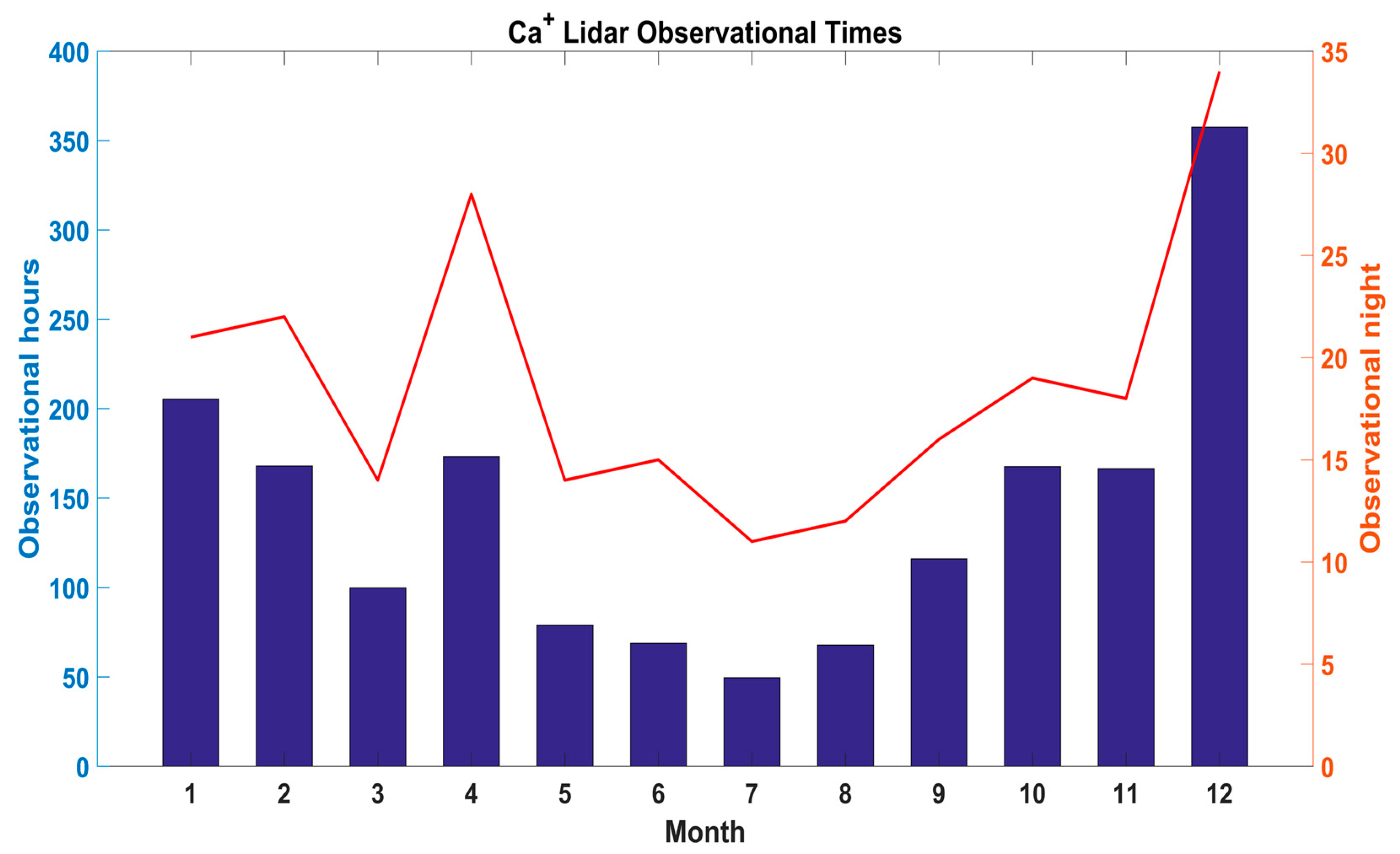
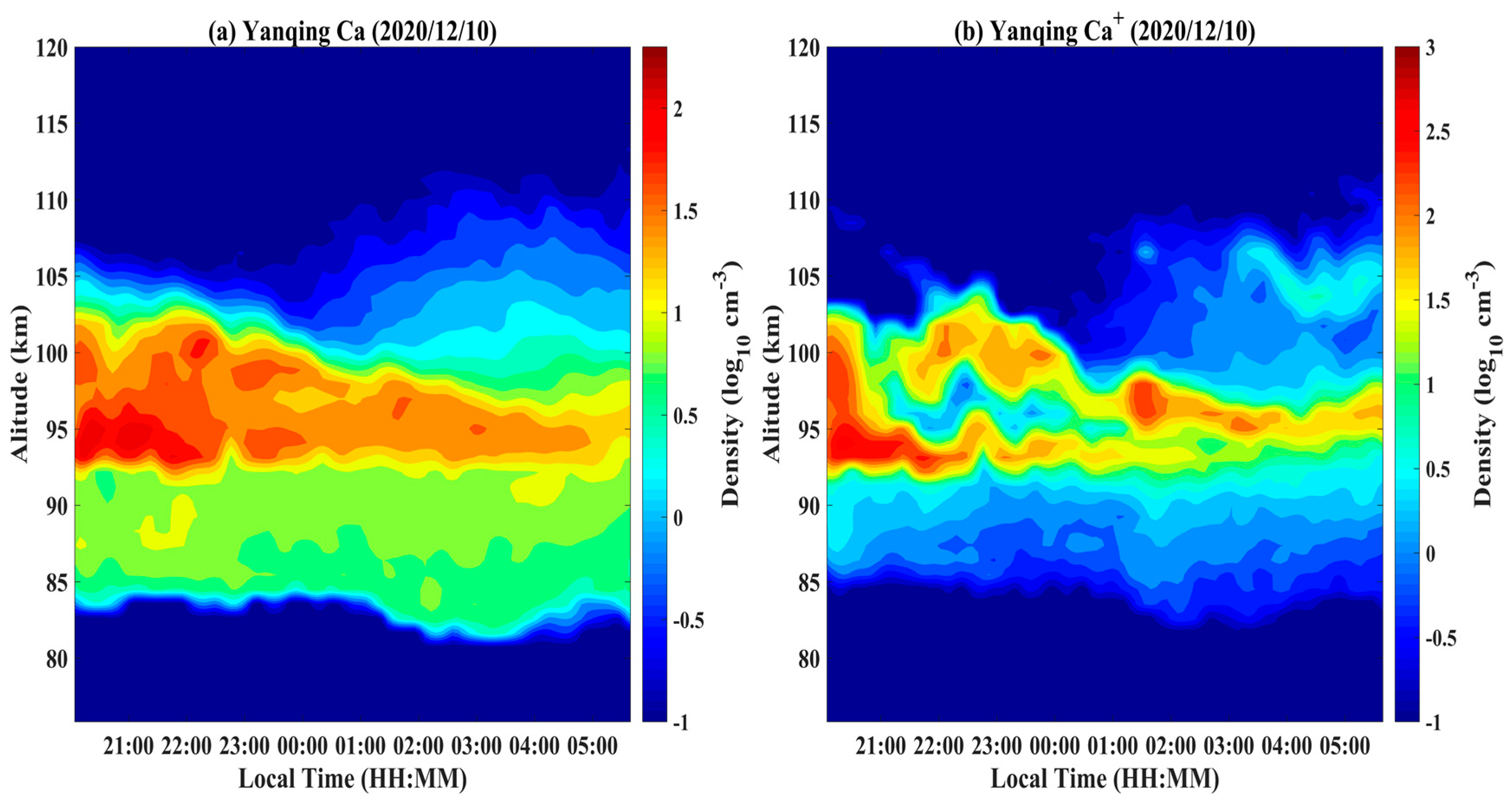
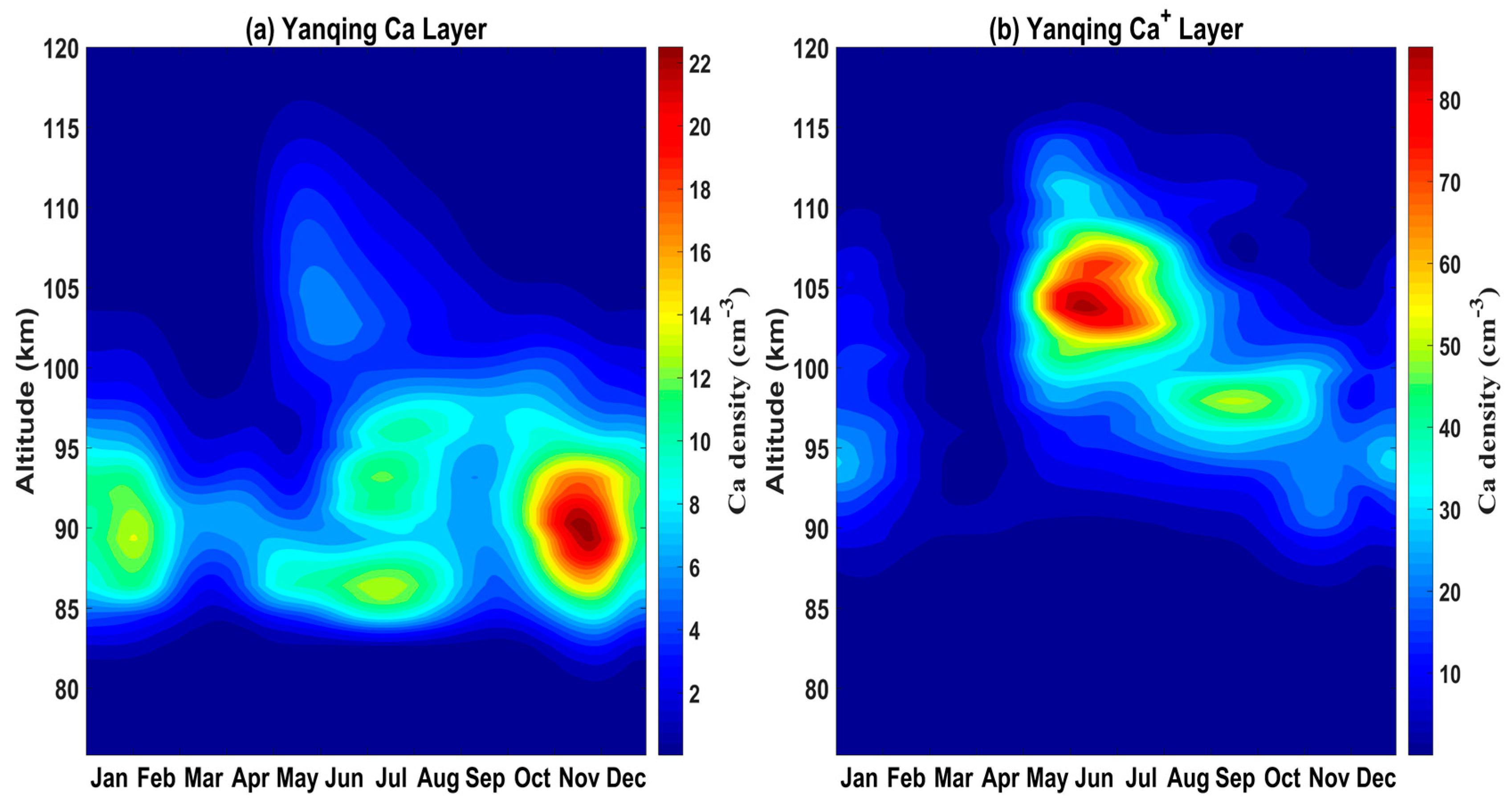
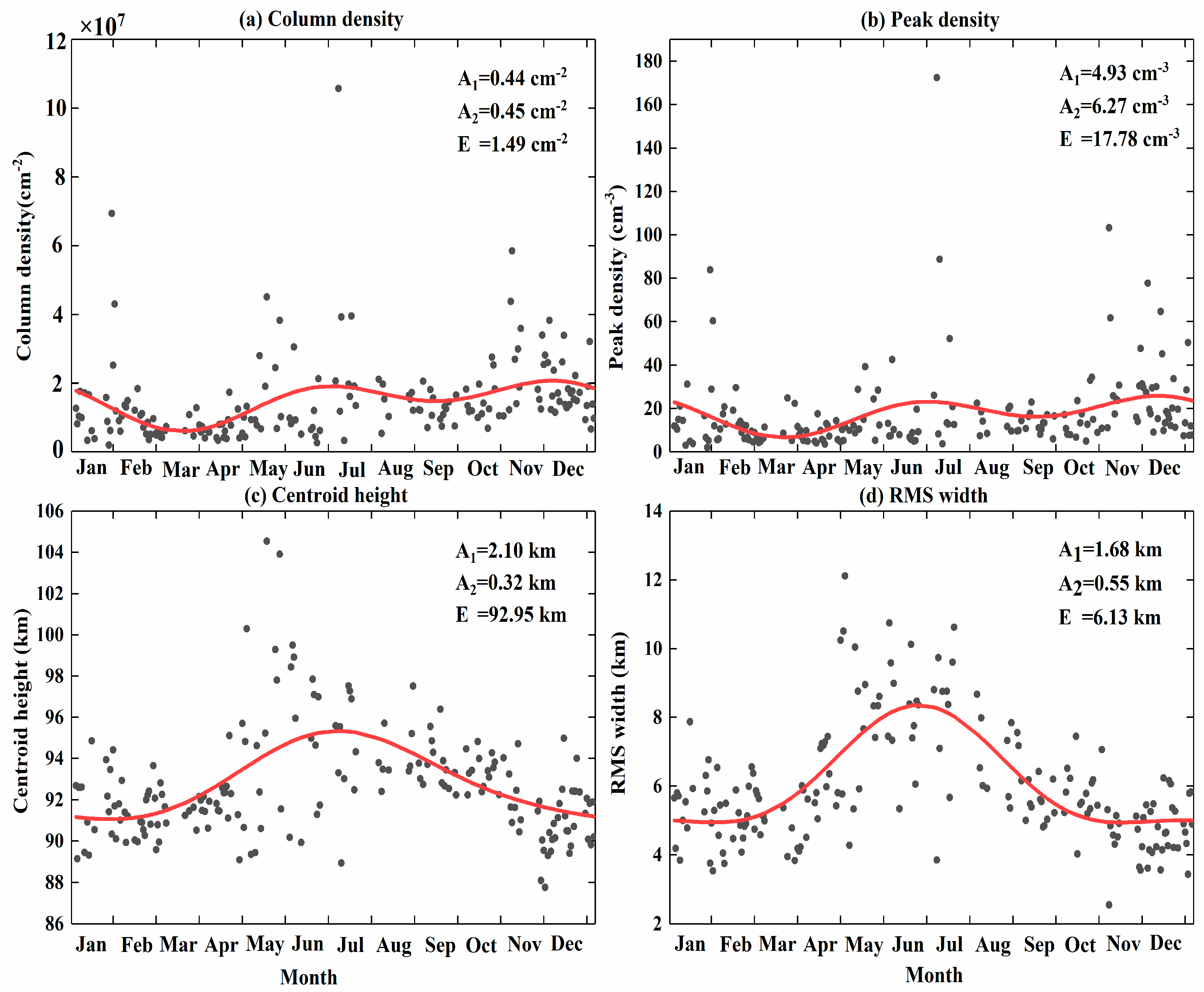
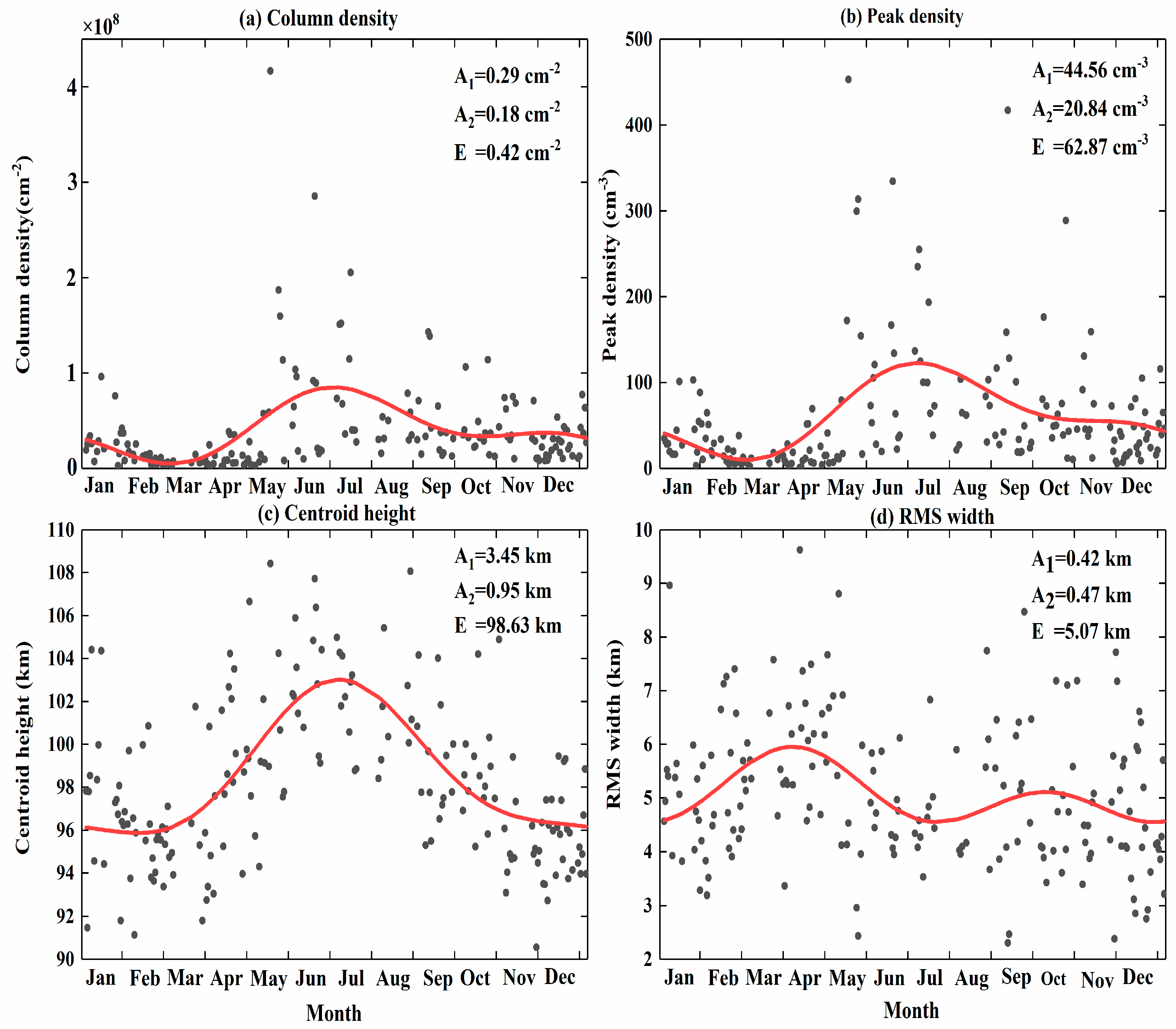
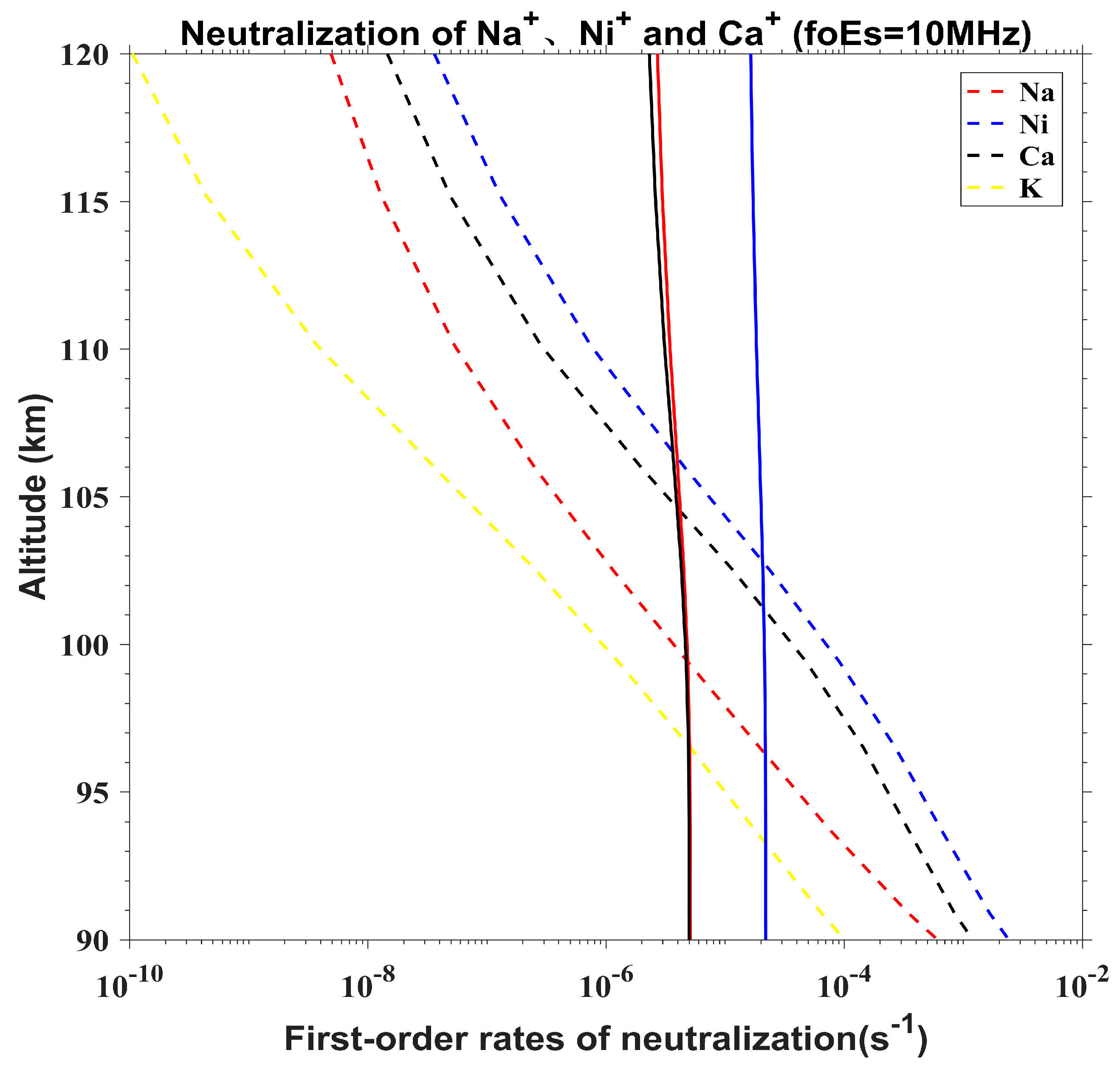
| Parameter | Ca | Ca+ |
|---|---|---|
| Laser wavelength (nm) | 422.6728 | 393.3663 |
| Laser linewidth (MHz) | 169.3 | 154.6 |
| Repetition rate (Hz) | 15 | 15 |
| Pulse energy (mJ) | 31 | 30 |
| Beam divergence (mrad) | 0.5 | 0.5 |
| Telescope aperture (m) | 1.23 | 1.23 |
| Focal length (m) | 2.4 | 2.4 |
| Fiber diameter (mm) | 1.5 | 1.5 |
| Optical filter FWHM (nm) | 1 | 1 |
| Time resolution (s) | 66.7 | 66.7 |
| Spatial resolution (m) | 96 | 96 |
| Count rate (MHz) | 150 | 150 |
Disclaimer/Publisher’s Note: The statements, opinions and data contained in all publications are solely those of the individual author(s) and contributor(s) and not of MDPI and/or the editor(s). MDPI and/or the editor(s) disclaim responsibility for any injury to people or property resulting from any ideas, methods, instructions or products referred to in the content. |
© 2024 by the authors. Licensee MDPI, Basel, Switzerland. This article is an open access article distributed under the terms and conditions of the Creative Commons Attribution (CC BY) license (https://creativecommons.org/licenses/by/4.0/).
Share and Cite
Xun, Y.; Zhao, P.; Wang, Z.; Du, L.; Jiao, J.; Chen, Z.; Zheng, H.; Gong, S.; Yang, G. Seasonal Variation in the Mesospheric Ca Layer and Ca+ Layer Simultaneously Observed over Beijing (40.41°N, 116.01°E). Remote Sens. 2024, 16, 596. https://doi.org/10.3390/rs16030596
Xun Y, Zhao P, Wang Z, Du L, Jiao J, Chen Z, Zheng H, Gong S, Yang G. Seasonal Variation in the Mesospheric Ca Layer and Ca+ Layer Simultaneously Observed over Beijing (40.41°N, 116.01°E). Remote Sensing. 2024; 16(3):596. https://doi.org/10.3390/rs16030596
Chicago/Turabian StyleXun, Yuchang, Peng Zhao, Zelong Wang, Lifang Du, Jing Jiao, Zhishan Chen, Haoran Zheng, Shaohua Gong, and Guotao Yang. 2024. "Seasonal Variation in the Mesospheric Ca Layer and Ca+ Layer Simultaneously Observed over Beijing (40.41°N, 116.01°E)" Remote Sensing 16, no. 3: 596. https://doi.org/10.3390/rs16030596
APA StyleXun, Y., Zhao, P., Wang, Z., Du, L., Jiao, J., Chen, Z., Zheng, H., Gong, S., & Yang, G. (2024). Seasonal Variation in the Mesospheric Ca Layer and Ca+ Layer Simultaneously Observed over Beijing (40.41°N, 116.01°E). Remote Sensing, 16(3), 596. https://doi.org/10.3390/rs16030596






